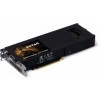- Qualcomm Launches Snapdragon 4 Gen 2 Mobile Platform
- AMD Launches Ryzen PRO 7000 Series Mobile & Desktop Platform
- Intel Launches Sleek Single-Slot Arc Pro A60 Workstation Graphics Card
- NVIDIA Announces Latest Ada Lovelace Additions: GeForce RTX 4060 Ti & RTX 4060
- Maxon Redshift With AMD Radeon GPU Rendering Support Now Available
Zotac GeForce GTX 285 & GTX 295

When NVIDIA released their GTX 285 and 295 earlier this month, they successfully reclaimed the performance crown for both single and dual-GPU graphics cards. We’re finally putting both of these models through our grueling testing, in both single card and SLI configurations, to see just how much value can be had when compared to previous offerings.
Page 4 – Crysis Warhead
As PC enthusiasts, we tend to be drawn to games that offer spectacular graphics… titles that help reaffirm your belief that shelling out lots of cash for that high-end monitor and PC was well worth it. But it’s rare when a game comes along that is so visually-demanding, it’s unable to run fully maxed out on even the highest-end systems on the market. In the case of the original Crysis, it’s easy to see that’s what Crytek was going for.
Funny enough, even though Crysis was released close to a year ago, the game today still has difficulty running at 2560×1600 with full detail settings – and that’s even with overlooking the use of anti-aliasing! Luckily, Warhead is better optimized and will run smoother on almost any GPU, despite looking just as gorgeous as its predecessor, as you can see in the screenshot below.
The game includes four basic profiles to help you adjust the settings based on how good your system is. These include Entry, Mainstream, Gamer and Enthusiast – the latter of which is for the biggest of systems out there, unless you have a sweet graphics card and are only running 1680×1050. We run our tests at the Gamer setting as it’s very demanding on any current GPU and is a proper baseline of the level of detail that hardcore gamers would demand from the game.



Only Crysis has the ability to prove to you just how inept that expensive graphics card of yours is, and it does a great job of that. Surprisingly, even with two GTX 295’s at 2560×1600, we were still barely able to tap the 60 FPS mark, and that’s without even a pinch of Anti-Aliasing! From a 1680×1050 perspective, any card will play the game just fine with the Gamer Profile, and for the most part, not much changes at 1920×1200.
Our top resolution of 2560×1600 is a far different story, though, as only three of our GPU configurations delivered enough power to be able to run the game at above 30 FPS, a range that I personally find suitable for normal gameplay. Even 30 FPS isn’t ideal, but I don’t think the performance is low enough to keep people away from enjoying improved visuals.
It’s pretty clear here. To enjoy this game at the Gamer setting without moving to an SLI setup, the only choice right now is the GTX 295, which came close to offering 40 FPS on average. Zotac’s AMP! GTX 285 came close to the 30 FPS we’d like to see, but no cigar.
|
Graphics Card
|
Best Playable
|
Avg. FPS
|
|
NVIDIA GTX 295 1792MB x 2
|
2560×1600 – Enthusiast, 0xAA
|
42.507 FPS
|
|
NVIDIA GTX 285 1GB x 2
|
2560×1600 – Gamer, 0xAA
|
45.835 FPS
|
|
Zotac GTX 295 1792MB
|
2560×1600 – Gamer, 0xAA
|
37.97 FPS
|
|
Zotac GTX 285 1GB AMP!
|
2560×1600 – Mainstream, 0xAA
|
53.308 FPS
|
|
NVIDIA GTX 285 1GB
|
2560×1600 – Mainstream, 0xAA
|
51.283 FPS
|
|
Palit GTX 280 1GB
|
2560×1600 – Mainstream, 0xAA
|
46.912 FPS
|
|
XFX GTX 260/216 896MB
|
2560×1600 – Mainstream, 0xAA
|
40.750 FPS
|
|
Diamond HD 4870 1GB
|
2560×1600 – Mainstream, 0xAA
|
33.849 FPS
|
|
Palit HD 4870 X2 2GB
|
2560×1600 – Mainstream, 0xAA
|
30.670 FPS
|
For the first time, we’ve finally seen a GPU configuration that would allow the Enthusiast setting at the ultra-high resolution of 2560×1600. Granted, it requires two $500 GPUs, but the fact that it can be done is impressive. The 42.507 FPS being delivered sure isn’t jaw-dropping, but it’s plenty-enough to deliver smooth gameplay at oh-so-gorgeous settings.
From a single-GPU perspective, the GTX 295 once again offers the best bang for the buck where quality and average FPS is concerned. SLI’d GTX 285’s improve upon that result by about 7 FPS, but $300 would also be tacked onto the cost-of-entry, so there’s a definite trade-off. Where the GTX 285 is concerned, it has easily become the fastest single-card single-GPU offering available today, and this table proves it. Sadly, at 2560×1600, the profile had to be kicked down to Mainstream, but for 1920×1200, the Gamer profile can be used just fine for any of the cards listed here.
Support our efforts! With ad revenue at an all-time low for written websites, we're relying more than ever on reader support to help us continue putting so much effort into this type of content. You can support us by becoming a Patron, or by using our Amazon shopping affiliate links listed through our articles. Thanks for your support!






